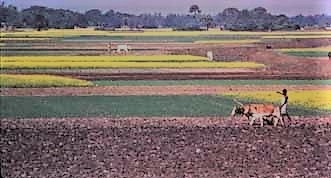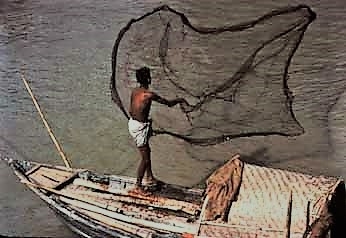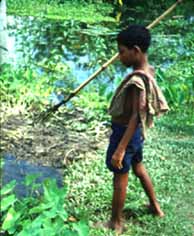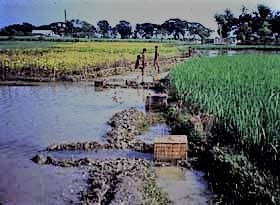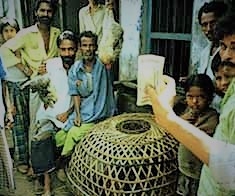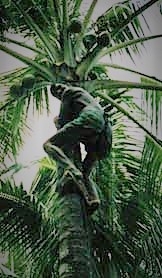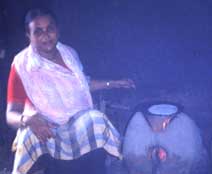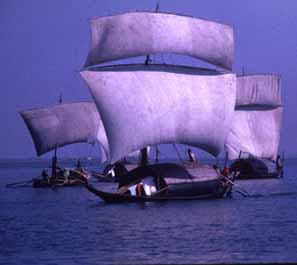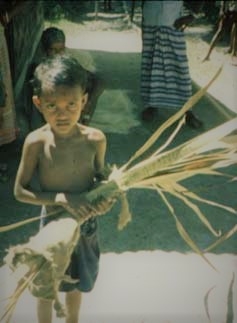I could write many more pages about Bangladesh, but perhaps you have seen enough to understand why I included the pictures and comments on a site about science toys. The Creator of our world put 96% of the human population in countries other than the one I was born in. I was lucky enough to have stepped completely out of my culture for awhile. Having my base assumptions about how things ought to be done stripped away was jarring, but revealed the world in a new light. Living in Bangladesh was pivotal to my education.
I do have to ‘fess up about one thing. I was supposed to research a needed technology, then develop and adapt it to the conditions that exist in Bangladesh. The idea worked before. Other people in my organization developed a reliable water pump for wells that was so inexpensive that even poor people could afford it. It became very popular in Bangladesh and even spread to other countries, providing clean water for millions of people as well as jobs for the people who made them.
So I was off! I was going to save the world—or at least Bangladesh—single-handedly in the three years of my term. There was the project to make paper out of weeds. There was the project to provide a mechanism to wind up twine as it was spun, for a women’s cooperative so they could work inside during the rainy season. There was the project to determine the most effective way to dry everything from spices to grated coconut, so farmer’s cooperatives could sell to the international market, and so on.
After a year in Bangladesh I was stricken with some severe health problems that were not necessarily related to being in Bangladesh. But I had to return home to get more specialized medical care. I never finished my work. Another person picked up the torch and carried on in my place.
I’ve harbored the wish that I could give something back to the people of Bangladesh for the education I got. Perhaps the preceding pages are my chance, even if it’s only to dispel some of the ignorance about them and pique some admiration for their resourcefulness.
I’d like to say a little more about the organization that sponsored me to go there, too. Although I had to leave before accomplishing my mission, there have been thousands of people who dedicated years of their lives to relief and development work throughout the world with the Mennonite Central Committee (MCC).
MCC is a productive and cost-effective charity because most of its workers are volunteers who commit to at least a three-year term. Some are just out of college with up to date skills and the energy of youth. Others have years of solid experience. Peace and social justice issues are very much on their radar, and they help people help themselves in practical ways.
I am not a card carrying Mennonite. Nevertheless, I have spent many hours trying to succinctly convey the respect I have for that organization of people who shared their vision with me. But there is just too much to say. For now, here’s the link to their home page. Poke around some. Their photo galleries are especially good. If you have gained something from this free science toymaker site, consider giving back by making a contribution to MCC.
I had to leave Bangladesh before I got all the pictures I wanted. Many thanks to the Dirks, Brubaker, Bergan and Wilce families, as well as to Dan Belgum, George Horlings, Kurt Wenger, Amos Showalter and Roger Waley who sent me slides for my collection. Umm, they got a little mixed up guys...contact me if there's a problem.
Mr. Sharifus Salekin is a small business owner who exports garments to the European Union. His wife--now a homemaker with their twin sons-- used to work for a British non-government organization. He has kindly provided some interesting information. (Note: That was back in 2004. We added some recent data for comparison) :
2004
2019 or Most Recent
- Population stands at 140 million
- Population is 163 million. (2019) UNdata (Click on "General Information")
- Nobody dies from hunger
- The leading causes of death IHME (2017) (Choose Bangladesh from Location menu)
- Stroke 18.2%
- Ischemic heart disease 14.8%
- COPD 7.3 %
- Number 1 position holder for 3 consecutive years as the most corrupted country ( and it seems no country could take this position from us !! ).
- Down to number 35th position (146/180) of the most corrupted country. (2019) Transparency International
- Cellular phone reached almost allover the country and total number of cell phones are 3 million+ now and will be 6 million+ by 2006.
- Number of cell phone subscriptions is 166 million. (Feb 2020)
Bangladesh Telecommunication Regulatory Commission (BTRC)
- Literacy rate reached at 51%
- Literacy rate (2018) UNESCO Institute For Statistics (Click on "Literacy Rate")
- 15 years and older 73.91% (Female 71.18% Male 76.67%)
- 15 - 24 years old 93.3% (Female 94.91%, Male 91.8%)
- Immunization rate is almost the best in the world (even better than USA!)
- Immunization coverage (%) 2019 WHO
-
- BCG 99
- DPT3 98
- OPV3 98
- MCV1 97
-
- Food production already 2.5 times more than in 1975
-
- Food Production Index (2016) World Bank
1975 48.77
2004 90.98
2016 145.31
- very good road network throughout the country
- Roadways (2018) CIA The World Factbook
Total: 369,105 km
Paved: 110,311 km
Unpaved: 258,794 km
- Everyday 5 villages has come under rural electrification program
- Electrification rate (2018)
National 84.9%
Urban 96.1%
Rural 78.5%
The International Energy Agency
- The ruling and opposition parties are head to head ( the leaders don't even talk to each other during the festivals !! )
- Bangladesh became the 8th largest Apparel producer and exporter in the world ( the industry grown at 236% per year ).
- Bangladesh is the 3rd largest clothing exporter in the world, after China and European Union. (2018) WTO
- Fish, vegetables, chicken etc being exported to Middle east , UK , USA etc.
- In 2018 Bangladesh exported $312M worth of food stuff, $474M worth of animal products. The Observatory of Economic Complexity
- Bangladeshi Medicine is being exported to EU !
- In 2018 Bangladesh exported $72.2M worth of packaged medicaments (substances used for medical treatment). The Observatory of Economic Complexity
Thank you Mr. Salekin!
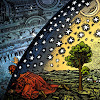
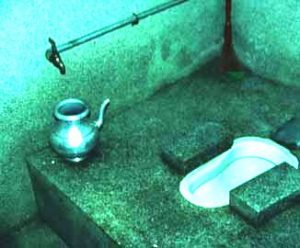
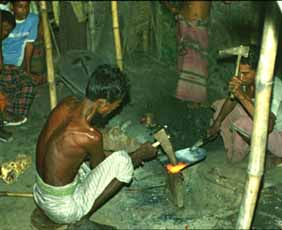
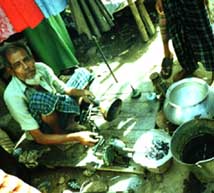 The tinsmith was in the market place in Feni, a fairly big town in southern Bangladesh where my wife and I spent three months learning the Bengali language. I was encouraged to spend time at the market place to practice the language. One day I took some old, dull scissors along with me because I was told there was a professional sharpener somewhere there. I asked around and finally found him.
The tinsmith was in the market place in Feni, a fairly big town in southern Bangladesh where my wife and I spent three months learning the Bengali language. I was encouraged to spend time at the market place to practice the language. One day I took some old, dull scissors along with me because I was told there was a professional sharpener somewhere there. I asked around and finally found him.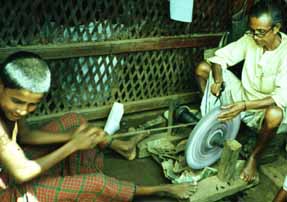 As soon as I saw him I knew I had made a mistake. As you can see, the setup was very crude. The man’s son would pull a rope to make the grindstone go around. Oh well, it was a lousy pair of scissors anyhow. He used the grindstone, then it turned out he had some other tools in the wooden box he was sitting on.
As soon as I saw him I knew I had made a mistake. As you can see, the setup was very crude. The man’s son would pull a rope to make the grindstone go around. Oh well, it was a lousy pair of scissors anyhow. He used the grindstone, then it turned out he had some other tools in the wooden box he was sitting on.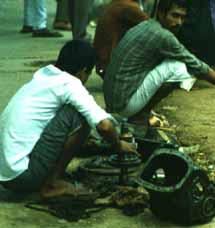
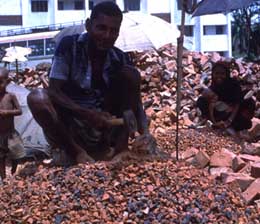 The people who do the brick breaking are the poorest of the poor. Although this family is working in the most prosperous area of Bangladesh, they still have a difficult life. The umbrellas are to shade them from the hot sun. Consider this “working mother” who has a sleeping baby in one hand and a hammer in the other. Bangladesh is one of the poorest countries in the world. These are some of the poorest people in Bangladesh.
The people who do the brick breaking are the poorest of the poor. Although this family is working in the most prosperous area of Bangladesh, they still have a difficult life. The umbrellas are to shade them from the hot sun. Consider this “working mother” who has a sleeping baby in one hand and a hammer in the other. Bangladesh is one of the poorest countries in the world. These are some of the poorest people in Bangladesh.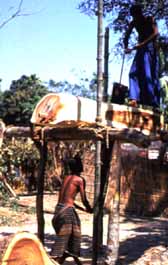
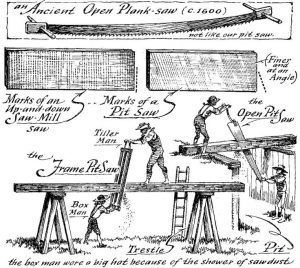
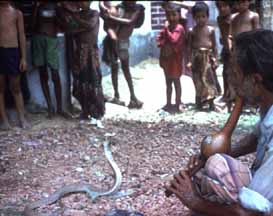 The best of the snake charmers put on a wild show. My brain was pretty sure the handlers took the venom out of the cobra snakes somehow. But my autonomic nervous system sent lots of adrenaline coursing through my veins in preparation for the fight or flight—more likely the later. Did you notice that these kids are quite interested, but they are not exactly pushing to get to the front of the crowd for a closer look?
The best of the snake charmers put on a wild show. My brain was pretty sure the handlers took the venom out of the cobra snakes somehow. But my autonomic nervous system sent lots of adrenaline coursing through my veins in preparation for the fight or flight—more likely the later. Did you notice that these kids are quite interested, but they are not exactly pushing to get to the front of the crowd for a closer look?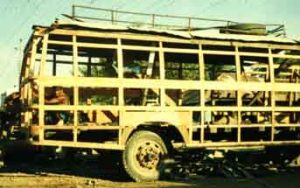
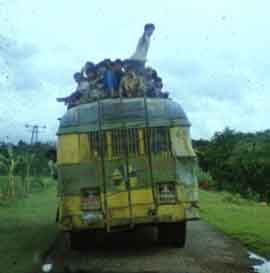
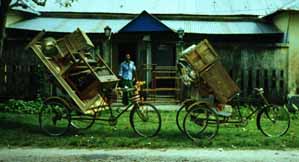 Tricycle rickshaws provided shorter-range transportation. The rickshaws driver was also the engine. Although primarily used to transport people, I have included a picture showing that the people are skilled at piling on and moving furniture as well. The topography of Bangladesh—no hills except on the fringes of the country—makes it well suited to rickshaws. I even saw a rickshaw school bus that held 6 young (privileged) kids.
Tricycle rickshaws provided shorter-range transportation. The rickshaws driver was also the engine. Although primarily used to transport people, I have included a picture showing that the people are skilled at piling on and moving furniture as well. The topography of Bangladesh—no hills except on the fringes of the country—makes it well suited to rickshaws. I even saw a rickshaw school bus that held 6 young (privileged) kids. There are many concrete bridges in Bangladesh that carry buses, but for the hundreds of thousands of small villages separated from the road by a canal, the people have to use a material they can afford: bamboo. I never heard of anyone slipping and falling in the water. I speculate that they are like gymnasts who use a balance beam from an early age. They become very good at it.
There are many concrete bridges in Bangladesh that carry buses, but for the hundreds of thousands of small villages separated from the road by a canal, the people have to use a material they can afford: bamboo. I never heard of anyone slipping and falling in the water. I speculate that they are like gymnasts who use a balance beam from an early age. They become very good at it.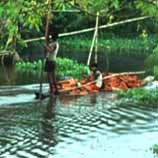 The cargo in this boat is bricks. Have you ever heard the expression, “Don’t rock the boat”? Literally how much can these guys rock the boat before it swamps and sinks like a ton of bricks? In every aspect of life it seems people in Bangladesh live on a knife’s edge, without a safety margin.
The cargo in this boat is bricks. Have you ever heard the expression, “Don’t rock the boat”? Literally how much can these guys rock the boat before it swamps and sinks like a ton of bricks? In every aspect of life it seems people in Bangladesh live on a knife’s edge, without a safety margin.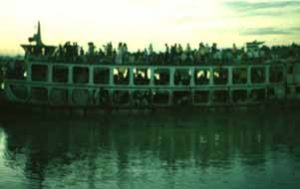 In Bangladesh, riverboats are still used to transport people. To visit projects in remote parts of the country I rode riverboats and felt some of the magic of the river. The stories about Tom Sawyer, Huckleberry Finn and life on the river came back to me with a new depth.
In Bangladesh, riverboats are still used to transport people. To visit projects in remote parts of the country I rode riverboats and felt some of the magic of the river. The stories about Tom Sawyer, Huckleberry Finn and life on the river came back to me with a new depth.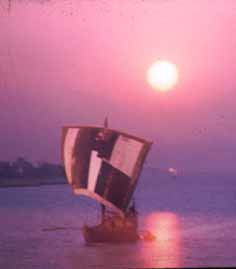 It’s a two edged sword, isn’t it? I don’t take the blessings of modern life for granted, having seen life without them. Aren’t we fortunate to have vaccines, education, swift transportation, food in abundance, the internet and so on? At the same time, I want to keep some old fashioned elements of life that will never be too old to be worth holding onto.
It’s a two edged sword, isn’t it? I don’t take the blessings of modern life for granted, having seen life without them. Aren’t we fortunate to have vaccines, education, swift transportation, food in abundance, the internet and so on? At the same time, I want to keep some old fashioned elements of life that will never be too old to be worth holding onto.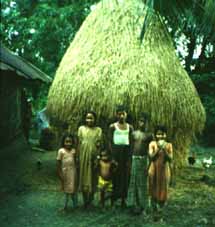 When I first went out of the capital city into the countryside, it seemed that a lot people must be living in Smurf huts. My heart went out to them, because it seemed like there wasn’t enough room to even lie down. Then somebody kindly informed me that those were in fact haystacks, not houses. They set a bamboo pole in the ground, then pile rice straw around it in a way that sheds rainwater. The cows eat it. The house in the picture above is actually off to the left. The kids insisted on being in the picture.
When I first went out of the capital city into the countryside, it seemed that a lot people must be living in Smurf huts. My heart went out to them, because it seemed like there wasn’t enough room to even lie down. Then somebody kindly informed me that those were in fact haystacks, not houses. They set a bamboo pole in the ground, then pile rice straw around it in a way that sheds rainwater. The cows eat it. The house in the picture above is actually off to the left. The kids insisted on being in the picture.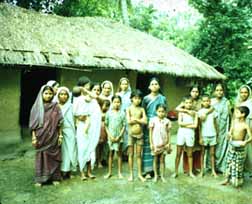 My wife and I spent the first three months we were there studying the Bengali language. We hired a babysitter to look after our one-year-old daughter during classes. One day we visited our babysitter’s “bari,” or village. The men were all out working the fields so only the women and children were there at the time.
My wife and I spent the first three months we were there studying the Bengali language. We hired a babysitter to look after our one-year-old daughter during classes. One day we visited our babysitter’s “bari,” or village. The men were all out working the fields so only the women and children were there at the time.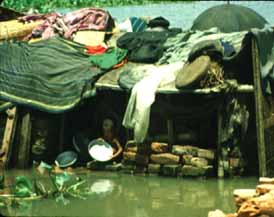 A hurricane has dumped a huge amount of water. The hurricane is gone, and the people have thrown the wet clothing and bedding on the roof to dry in the sun. The big problem is that it might take a couple of weeks for the water to recede. In the mean time, they are living on stacks of bricks.
A hurricane has dumped a huge amount of water. The hurricane is gone, and the people have thrown the wet clothing and bedding on the roof to dry in the sun. The big problem is that it might take a couple of weeks for the water to recede. In the mean time, they are living on stacks of bricks.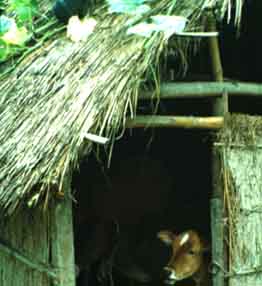 On a lighter note, here is a picture of a barn. One of the recurring themes is that nothing is wasted. Not even the sunlight falling on this thatch roof. Squash vines are trained to climb up onto roofs and spread out and soak up the sun. Squash vines are also trained out onto trellises over ponds, where the fish seem to prefer the shade.
On a lighter note, here is a picture of a barn. One of the recurring themes is that nothing is wasted. Not even the sunlight falling on this thatch roof. Squash vines are trained to climb up onto roofs and spread out and soak up the sun. Squash vines are also trained out onto trellises over ponds, where the fish seem to prefer the shade.